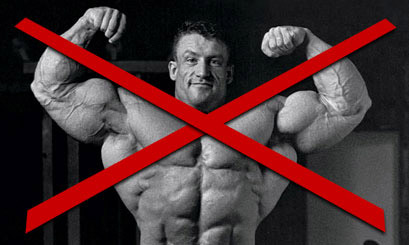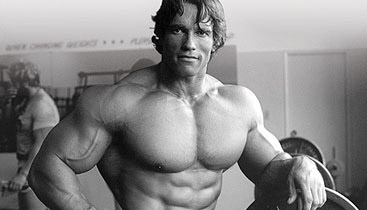“I DON’T WANT TO GET TOO BIG!” (LEAN MUSCLE VS. BULKY MUSCLE)

Though it might sound strange to those dedicated bodybuilders out there who operate on the automatic “bigger is better” mentality, not every person who works out at the gym is interested in building a hugely muscular body.
Many trainees would be much happier going for that athletic, “lean fitness model look” by aiming for a reasonable level of muscular development but not necessarily maxing out their gains.
It’s a question I receive all the time from both women and men…
“Sean, I want to start working out and putting on some muscle, but I don’t want to get too big. How should I train and eat so that I can build muscle without getting bulky, and what should I do to maintain my gains once I reach a level of muscularity that I’m happy with?”
The Truth About Building Muscle “Without Getting Bulky”

The problem with the “I don’t want to get too big” question is that it’s coming from a highly skewed perception of just how quickly (or rather, just how slowly) the average person’s body actually gains new muscle.
These unrealistic expectations are brought about by many sources….
– Magazine covers and online photos portraying bodybuilders and fitness models who bothpossess elite-level genetics and are further enhancing that potential through the use of steroids and other drugs.
– Advertisements for diets, workouts and supplements that guarantee absurd, completely unrealistic results by promising that you’ll “Gain 24 Pounds Of Muscle In 8 Weeks” or “Add 2 Inches To Your Arms In 1 Month”.
– The “buff guy” at the gym with the highly impressive physique who, unknown to the beginning lifters around him, built his body through many years (NOT weeks or months) of consistent, focused training and nutrition.

In any case, assuming that you possess average muscle building genetics and are not “chemically enhanced” in any way, building muscle is going to be a very slow and gradual process for you, just like it is for everyone else.
Just how gradual of a process are we talking here?
Well, if you’re a male and are a complete beginner (keep in mind that the less experienced you are, the faster you’ll be able to build muscle, and vice versa), you can probably expect to put on around 0.25 – 0.5 pounds of actual lean muscle per week assuming that you’re doing everything correctly.
Since women have much lower natural testosterone levels than men do, females can expect to progress at a rate roughly half of that or even slightly lower.
In other words, unless you choose to intentionally not look at yourself in the mirror, not weigh yourself and not go out in public for a very lengthy period of time, the likelihood that you’ll suddenly wake up one day to realize that you’ve “gone too far” and have accidentally gotten “too big” is virtually non-existent.
Instead, you’ll always see your increases in muscle size unfolding from a mile away and will easily be able to adjust and tweak your approach accordingly as you move forward.
For that reason, even if you’re not ultimately looking to build a huge amount of muscle in the long run, your best bet is still to structure your program in a way that maximizes your current rate of growth.

Unless you’re completely and absolutely out to lunch on this, there is no realistic scenario where you’ll mistakenly get “too big” or “too bulky”, and intentionally taking actions to slow down your muscle building progress right from the start is only going to increase the chances that you’ll end up failing altogether.
Whether the person emailing me for advice is a female looking to put on 8 pounds of muscle and get a “lean and toned” body or a male looking to gain 40 pounds of muscle and get as big and ripped as possible, the basic bodybuilding approach I would give to each of them would ultimately be the same.
They’d be training intensely in the gym 3-5 days per week and centering their workouts around basic free weight compound exercises, low to moderate reps and a focus on progressive strength gains over time…
They’d be consuming a moderate 15-20% calorie surplus each day derived from high quality proteins, minimally refined carbs and healthy fats along with a few basic supplements if necessary…
They’d be getting quality sleep each night… drinking plenty of water… and implementing all of the other strategies that I teach in my program and in my articles and videos designed to build muscle as quickly as possible.
If a situation eventually arose where either person reached a level of muscular development that they were completely satisfied with, they could then make adjustments to their plan in order to prevent further muscle growth and to just maintain their current build.
The simple way of doing this is to keep everything in your program the same in terms of training and nutrition, except to lower your daily energy intake from a calorie surplus down to your calorie maintenance level.
Since your body will now have no excess calories to divert to new muscle growth (a calorie surplus is a mandatory prerequisite for building muscle), you’ll simply end up maintaining whatever amount of muscle you’re currently carrying as long as you continue training intensely in the gym.
In fact, this is the exact approach I currently take with my own program. I’m quite content with my current level of muscle development and have no desire to put on additional size right now, so I simply eat at my calorie maintenance level of around 2700-2800 calories a day, train hard in the gym 5 days per week and my body weight always remains stable at about 170 pounds.
“I Don’t Want To Get Too Big” – The Bottom Line

Whether you’re a male or a female, and whether you’re aiming to gain 5 pounds of muscle or 50, there’s no need at all to worry about “getting too big” or intentionally structuring your program in a way that moderates how quickly you put on new muscle.
Even if an average male is training and eating perfectly for his body type, he’ll still only put on around 2 pounds of actual muscle per month as a beginner, with the rate of growth steadily decreasing as he becomes more experienced. For women, gains will come at about half that speed.
On top of this, always keep in mind that there is no such thing as “lean muscle” versus “bulky muscle”. Muscle tissue is muscle tissue, and you’re either gaining it, maintaining it or losing it.
Someone who you consider “too big” is not that way because they somehow possess a different “type” of muscle. Rather, they’re simply carrying a larger amount of it, the appearance of which may then be even further “enhanced” due to low body fat levels.
So, if you’re wanting to put on some muscle, just aim to maximize your rate of growth regardless of how much you’re specifically aiming for.
It’s likely going to be a longer process than you imagine, and your body will change at such a gradual pace that you’ll be able to easily modify your approach moving forward without any worry of accidentally “going too far”.
If you found this article helpful, make sure to sign up for your FREE custom fitness plan below...




